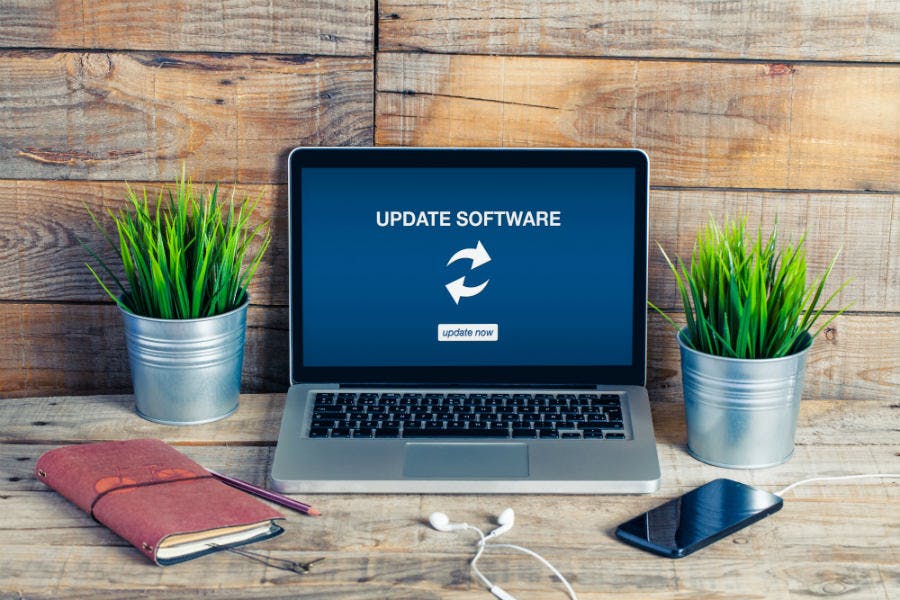Let’s face it - you’re busy and you don’t always have time to do the small things you know need doing. So these small things can sometimes slip through the cracks. And then suddenly it’s a year later and you still haven’t done them.
When it comes to tech tasks, there are a few common culprits. Here’s a list of five that might sound familiar - complete with reasons to take them on, as well as step-by-step instructions on how to do so.
Update your software
You’re clicking around the internet when suddenly your browser chirps with a warning that it’s out of date. Or maybe a plugin says there’s a new update available. Or maybe you’ve logged for a little bit of game time and it asks if you’d like to update the game you want to play.
This isn’t to mention the prompt to update the database for your anti-virus and anti-malware software - two crucial features that get overlooked on a regular basis.
Whatever the interruption, you ignore it. You’re busy and don’t want to be disturbed! Besides, the last time you updated something it took like five minutes out of your day to complete - and then you had to restart the system!

How often do you ignore these messages?
Sounds familiar? You’re not alone. The truth is that many of us ignore the updates just because it would disturb the flow we had planned - and there are so many updates to consider.
However, the program designers and app developer aren’t trying to disturb your day or get in the way of your productivity (or in the case of games, your “productivity”). They just want to keep you, your information, and your hardware safe. These updates often contain important upgrades that impact the performance, stability, and security of the programs that run on your device. Keeping them up to date is one way of making sure that your tech ecosystem keeps on keeping on as efficiently and securely as possible.
This is because many of the web exploits and malware look for outdated software with unpatched security flaws to take advantage of - especially for operating systems. According to an interview with Kaspersky Lab’s senior anti-virus researcher Roel Schouwenberg, the most vulnerable software in the market includes Java (56%), Adobe Acrobat Reader (25%), Windows and Internet Explorer (4%), Adobe Flash (3%), and Android Root (2%). The remaining 10% is a list of smaller, less popular programs and extensions.
As a guide, if the big developers like Microsoft, Apple, and Google say that an update is “recommended” and is not listed as being “optional”, you really should install them. They should know - they wrote the stuff in the first place.
The best part? All it really takes is a click.
Virus scans
One of the most commonly skipped menial tasks is also one that’s easy to automate - virus and malware scans. Once considered an essential part of common device maintenance, studies have shown that many users - even professionals who work within IT - sometimes go for months without running these simple scans.
The reasoning is understandable - if a device is working reasonably well, then they assume that it is safe from viruses and malware. They think that the software is doing its job. By the time a virus eventually makes its way into their system, it’s too late.
Think about how much you rely on your technical devices every day. You’ve got work data, budgeting spreadsheets, important emails, and documents such as resumes. All of this could get lost in a matter of seconds.
Then you have your sensitive information. How much effort would you have to go through if your identity was stolen? How much time might you spend trying to sort things out? How much would it cost to get it back?
Regular scanning doesn’t need to be a chore - most programs can be set to run quietly in the background, and have options to perform either a quick, resource-intensive scan or a slower, lightweight scan which leaves resources free so that users can continue to work.
You could even set it up so that the program runs a scan once a week - maybe first thing Monday morning while you have your first coffee of the day or last thing Friday afternoon before you clock off.
Put like this, there are really very few good reasons to put off a regular virus scan. Again, all it takes is a click!
Clean up space on on your PC
How often do you deliberately clean up the hard drive on your PC? Unless you use a schedule feature, chances are that the answer is “not often”.
The amount of space your PC has impacts on all sorts of areas. If you run short, you could experience slow-downs in performance. You could find that certain programs freeze in the middle of performing an action. Most obviously, you could run out of space for new files.

If you overfill anything it can make life difficult.
Your PC’s hard drive stores everything you use - the operating system, programs, and software, through to your movies and music files. As a rule of thumb, you need to keep about 10 per cent of your hard drive space free for optimal performance. If your computer is acting slow, cleaning out files you no longer need can help improve performance.
There are several ways to achieve this.
The first is to uninstall programs you don’t need or rarely use.
To do this:
- In Windows, go to the "Start" menu, then click on "Control Panel".
- Select "Add or Remove Programs" to see what programs are installed
- Arrange the programs by “date installed” so you have an idea of how long they have been on your system, then decide which ones to remove.
- When you find a program that you don't need or want, select it and click "Remove." The program will be uninstalled from your computer.
- You may need to restart the computer after performing these operations.
The second option is to perform a disk cleanup:
- In Windows, go to the "Start" menu, then click on "My Computer."
- In the "My Computer" window, right-click on the C: drive (this could also be named “Local Disk” or “Main Hard Drive”) then select "Properties" at the bottom.
- This will bring up the Properties window. This window will display a pie chart showing the space on your hard disk.
- Click on the "Disk Cleanup" button. After a little time calculating, this will display a list that shows all the temporary Internet files that you viewed, program files you have downloaded, and temporary files that you have saved. Decide which options to clean out by looking at the descriptions and checking the box next to the ones you want to be deleted. If it says, "You can safely delete these files," then make sure to include them. Any files you leave unchecked will be left alone.
- Click "Clean Up" to delete the selected files. Click "OK." This gives you a little more space on your computer.
The last option you have is to perform a disk defragmentation operation. Your computer is designed to write files and fragments of files on the most convenient place on the hard disk. This helps improve writing speeds, but over time it can degrade performance, as it has to physically move the disk and disk heads to various locations to find the files it needs. A “defrag” operation literally “de-fragments” all the related files it can, putting them in one piece and sitting close to each other on the disk.
Please note that this operation is not necessary for solid-state or flash memory drives, as these drives have no moving parts and do not benefit from defragging. In fact, defragging can reduce their lifespan.

Defragging your hard drive only works for magnetic drives, not solid-state-drives.
To defrag your computer:
- For Windows, go to "Start" and click "My Computer." For Vista, go to "Computer".
- In the "My Computer" window, right-click on the C: drive, which is the Local Disk (or Hard Drive), then select "Properties" at the bottom. A window will appear. Inside the Properties window, a pie chart will appear showing your computer's capacity, according to free space and used space.
- Click on the "Defrag Now" button. This will analyze the space and data on your hard drive. It will take awhile.
- Once finished, it will inform you if you need to defrag. If so, click on the "Defragment" button.
Backup and delete your old photos and files
Be honest - a lot of the photos, music, and videos you have on your devices don’t see an awful lot of use. It’s nice to have them on hand, but most of the time they are just sitting there taking up space.
You only really need to have them on hand if you’re in a position to use them frequently. So why not perform that spring cleaning session you just know your device needs? Besides, minimalism is good for your brain!
The first step is to just remove all your unwanted files. The party photos, the duplicate music files, the seasons of M*A*S*H you’ve watched a million times. Time to say goodbye. Make sure they are deleted from storage and not just moved to the Recycle Bin or Trash.
The second is to move infrequently accessed files - the stuff you know you will need later - onto secondary storage. This could be a burnable DVD, a flash drive, or an external hard drive. Once they have been successfully transferred, you can delete them straight from storage.
For photos, the answer is obvious. If you have special ones, get them printed for display. Share the pleasant ones on social media. And delete the rest.

Maybe it’s time to print out those family photos?
This keeps all your important media accessible, but frees up space on your device - as well as giving you peace of mind.
Physically clean your gear
When was the last time you cleaned your smartphone? You know, the device you spend all day touching with your hands. The same hands that touch other things that other people have touched.
You know where your hands have been. Do you know where their hands have been?
You bring your smartphone with you everywhere you go. To work, to lunch, to the pub, to the bathroom. Don’t forget - you put this device up next to your face to take a call.
Add all this up and it paints a compelling reason to clean your smartphone regularly. Weekly would be ideal - if not daily. And for the most part, it’s not that hard.
While your keyboard, smartphone or tablet are not likely to be waterproof - they do exist, but they’re not cheap - the steps involved are quite simple:
Power down the device.
Remove any cover you are using.
Spray a tiny amount of eyeglass cleaning solution onto a piece of lint-free microfiber cloth (the kind you use for your spectacles) and wipe your screen.
Use a small amount of alcohol-based hand sanitiser with a paper towel to wipe down the smartphone chassis.
Wait until the sanitiser evaporates, then buff any residue off with a fresh paper towel.
Wipe down the covers and protectors with the glasses cleaner and a fresh paper towel.
Dry the covers and the protectors with a fresh paper towel.
Replace the covers and protectors on the device.
Restart your device.
A few quick notes:
- Alcohol hand cleanser can damage some screen coatings (anti-grease, anti-shatter, anti-glare), so be sure to avoid contact.
- Don’t use any soap or detergent on screen as these will leave a film.
- Please do not use water to clean your device unless you are 100% certain that it is waterproof.
What are some of the other tech-related tasks you think you have been putting off?